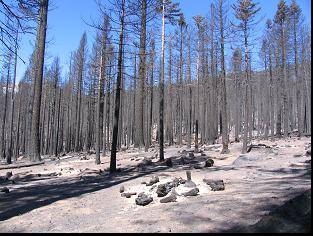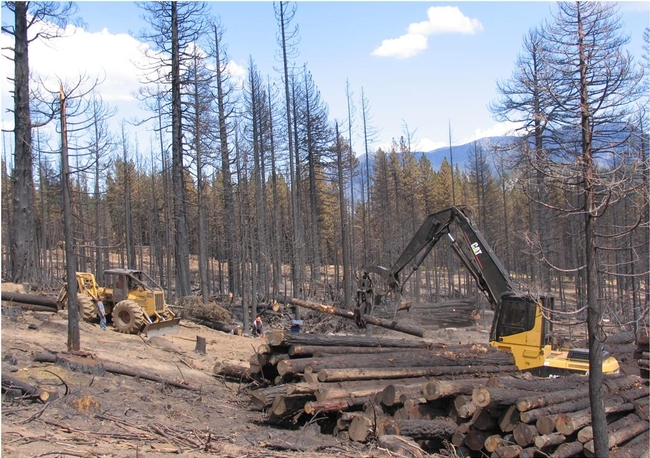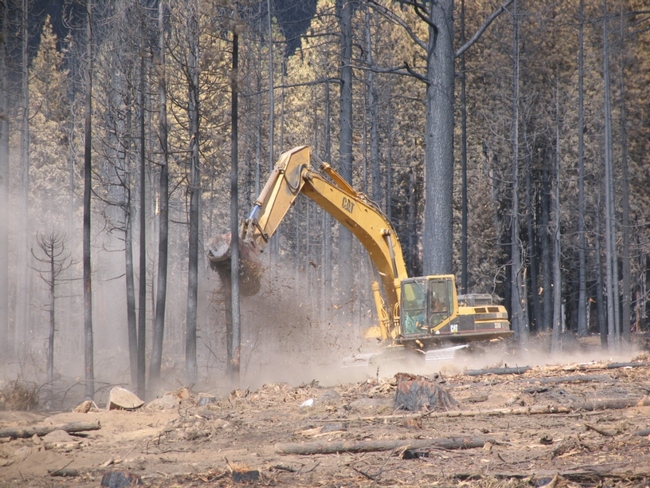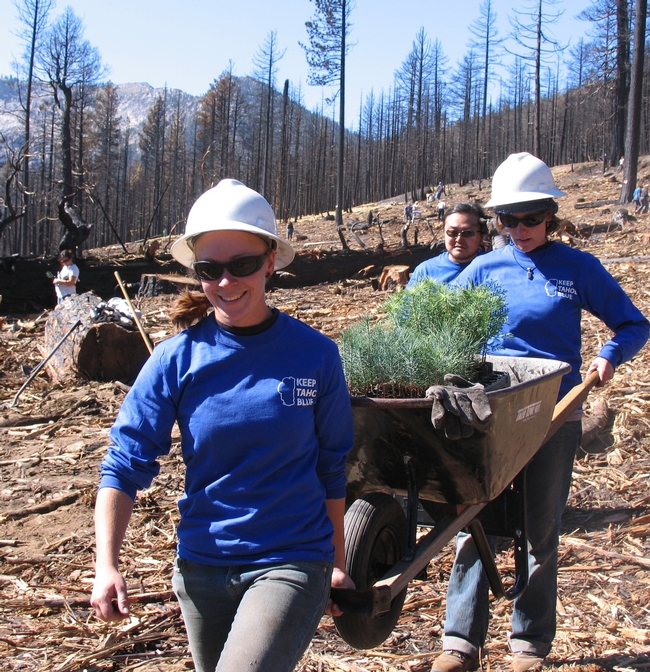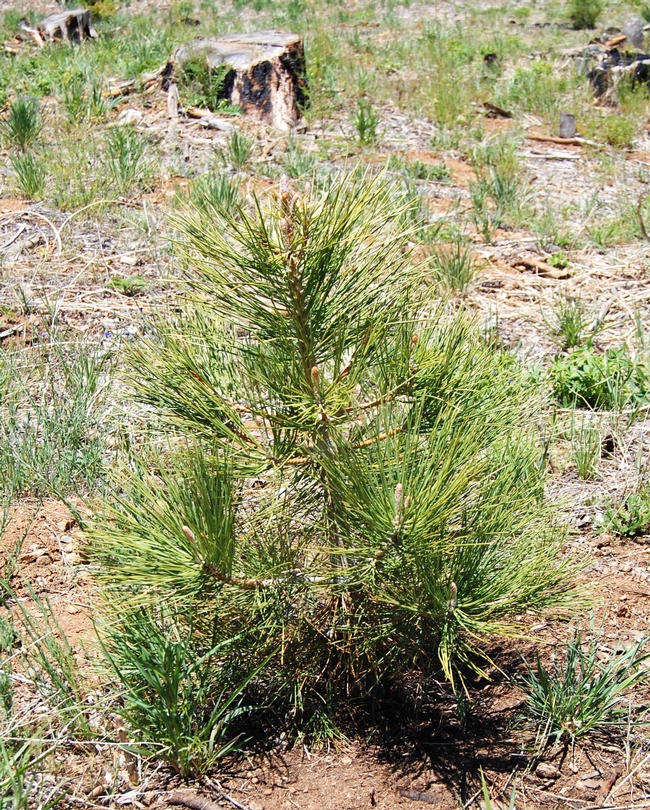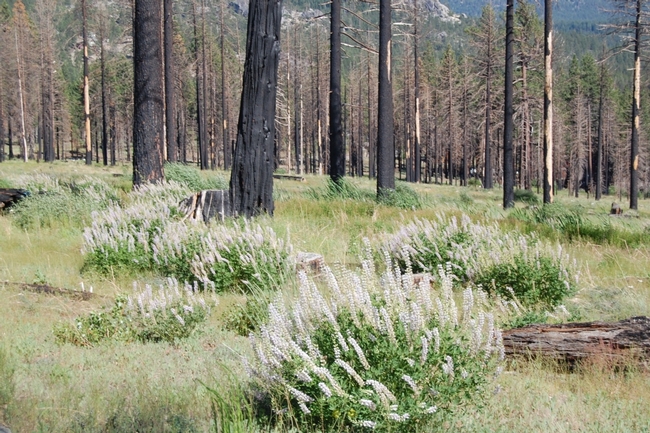Posts Tagged: wildfire
Plants need 20 years to recover after a devastating fire
When plants have at least 20 years to recover after a fire, they can go on for hundreds of years as a healthy habitat without fire, reported the Orange County Register.
The newspaper included this information in a graphic accompanying an article about the five-year anniversary of the devastating Santiago Fire, which scorched more than 28,000 acres and destroyed 42 structures in Orange County.
Sources of information for the plant recovery graphic included the UC Integrated Pest Management Program. If a fire occurs before the 20-year benchmark passes, it interrupts native plant progression and allows non-natives to take hold.
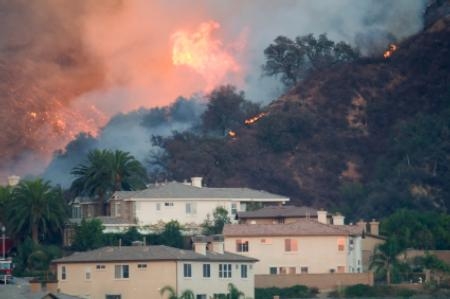
The Santiago Fire looms over large Orange County homes.
Climate change fuels western wildfires
From California’s Ponderosa fire to Colorado’s record-breaking Waldo Canyon fire and other blazes burning across the West, the summer of 2012 -- like many recent summers -- has been marked by a long, intense wildfire season. It has claimed thousands of acres, hundreds of homes, and in some cases, lives.
Malcolm North, professor in the Department of Forest Ecology at UC Davis and U.S. Forest Service research scientist, studies the effects of fire on Sierra Nevada coniferous forests. In this video, North explains how climate change and a history of fuel suppression in the forest mean wildfires will burn hotter, faster, longer and more often -- indefinitely.
“I believe very strongly we’re going to have more fires, larger fires, and those fires are going to be of higher severity,” he says. “We do need to figure out a means of making the forest more resilient.”
North is principal investigator on the Teakettle Ecosystem Experiment, which is looking at the effects of fires and forest thinning on a forest ecosystem.
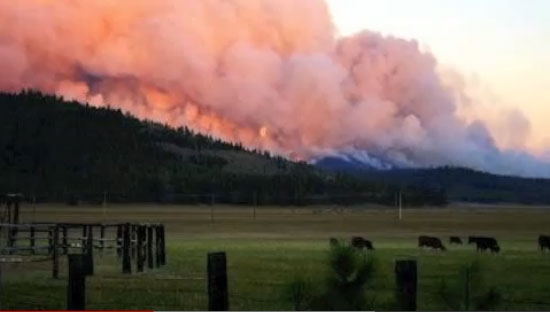
The Moonlight Fire of 2007, which burned about 70,000 acres, is an example of a high-intensity fire.
Forest lands may benefit from active restoration after wildfire
In the many forested areas where wildfires are currently burning, the question will soon arise: What should be done after the fire goes out? That depends on the severity of the burn and land owner goals.
For high severity burns where very few or no live trees remain to provide seed for the next generation, forest recovery can take a very long time. Typically forest landowners want to restore their lands to a forested condition as quickly as possible. In that case, an active approach can help them reach their goal sooner.
The California Tahoe Conservancy has just released a report on the outcomes of active restoration of 40 acres of Conservancy lands where all trees were killed by the 2007 Angora fire in South Lake Tahoe. That fire burned 3,100 forested acres as well as 250 homes.
Post-fire Conservancy goals were to re-establish a native forest, reduce hazards posed by dead trees, and avoid water quality impacts. Contractors cut large dead trees, skidded them to a landing, loaded them on a log truck and sent to a nearby mill. Some large dead trees were left on site to provide wildlife habitat. Small trees were ground up (masticated) and left on site to control erosion and suppress competing vegetation. Then one- to two-year-old native conifer seedlings were planted.
The report's authors estimate this active approach has hastened the return to a forested condition in the area by about 60 years. This is because planted seedlings are growing quickly while there are few naturally sprouting tree seedlings in adjacent untreated areas and these face competition from vigorously growing native brush that was stimulated by the wildfire. Soil monitoring showed no compaction by heavy equipment during tree removal and minimal soil erosion. Woody mulch left on site was also effective at suppressing brush to give newly planted tree seedlings a competitive edge.
Landowners looking for guidance on post-fire forest management are encouraged to download the free UC Cooperative Extension publication “Recovering from Wildfire: A Guide for California Landowners” and consult the UC Center for Forest Research and Outreach website at http://ucanr.edu/forestry.
Wildfires ignite debate on global warming
UC Cooperative Extension specialist Max Moritz has noticed that reporters are displaying a keen interest in the role played by global warming in what has so far been an unusually fierce 2012 fire season.
"For me, that marks a significant shift," wrote Moritz in a op-ed published in Nature yesterday. "This fresh curiosity about the link between fire and climate change is an important opportunity, of sorts."
Moritz, a wildfire expert in the UC Berkeley Department of Environmental Science, Policy and Management, is the author of a journal article published this summer in Ecosphere that linked climate change to global fire activity. The article is cited on a press release from U.S. House of Representatives Natural Resources Committee Democrats that calls for a hearing about reducing wildfire risk.
In the Moritz op-ed, he notes that a second common question from the press about the 2012 fire season is: “If these fires are related to climate change, what can we do about it?”
The inquiry, he said, reveals a growing anxiety over how humanity can adapt to the fire-related impacts of climate change, rather than how to mitigate climate change itself.
"To co-exist with fire will require extending our approach to living with environmental risks," Moritz wrote. "Mapping other natural hazards, such as flood and earthquake zones, has taught us to avoid building on the most dangerous parts of the landscape or to engineer solutions into the built environment when we do. Encouraging the 'right kind of fire' — with frequencies, sizes and intensities appropriate to the ecosystem in question — will be necessary, where possible, so that 'record-breaking' fires are less likely to occur during 'record-breaking' heat or drought."

For some people, climate change will become a fact only when its effects hit close to home.
Wildfire season is upon us
I’m from San Diego. We don’t get a whole lot of extreme weather in San Diego. My comfortable temperature tends to range from 70 to 80 degrees. We don’t get snow, no hurricanes, no tornadoes. But we do get the Santa Anas—hot dry winds blowing out of the desert. Which means we get wildfires. I’m fairly familiar with wildfires. So much so, that I once mistook snow falling from the sky for ash falling from the sky. (Like I said, I’m from Southern California).
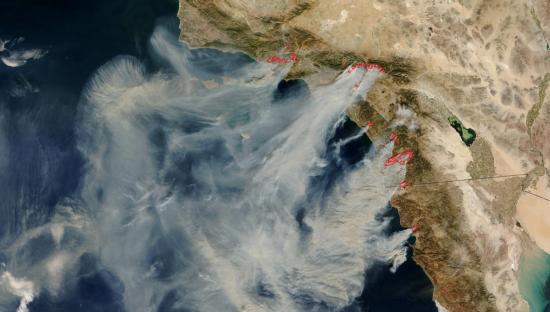 Our last big fires were in 2007, when half a million people were evacuated from their homes, including myself. It was a scary time. In San Diego, we were surrounded. There were fires to the north, east and south of us, and the ocean to our west. There was no way out. So much of Southern California was up in smoke, satellite images made it look like the entire bottom half of our state was burning. For weeks after, we walked around wearing masks as the winds tried to make up their minds about which way to blow the smoke. At the time I worked for a social service program with a fairly robust wildfire recovery program, and I saw firsthand the damage the fires had caused for so many families.
Our last big fires were in 2007, when half a million people were evacuated from their homes, including myself. It was a scary time. In San Diego, we were surrounded. There were fires to the north, east and south of us, and the ocean to our west. There was no way out. So much of Southern California was up in smoke, satellite images made it look like the entire bottom half of our state was burning. For weeks after, we walked around wearing masks as the winds tried to make up their minds about which way to blow the smoke. At the time I worked for a social service program with a fairly robust wildfire recovery program, and I saw firsthand the damage the fires had caused for so many families.
Now, five years later, wildfire season is once again upon us, and conditions aren’t looking so good. California rainfall was below-average this year, causing our vegetation to dry out sooner than expected. When you mix that with the high temperatures being predicted for this summer, the threat for fire danger is high. The National Oceanic and Atmospheric Administration has already started putting out critical fire weather headlines for Southern California, and elsewhere in the southwest.
Help mitigate this fire season by making sure you’re prepared. UC Agriculture and Natural Resources has a wealth of information to help you mitigate the wildfire potential in your area and keep your home safe. The Homeowner’s Wildfire Mitigation Guide, The Combustibility of Landscape Mulches and Fire Information Engine Toolkit compiled by scientists from UC Cooperative Extension and UC Berkeley, are great resources for homeowners in fire-prone areas. The information will help you understand how houses ignite and what to look for when fire-proofing your home this season.
Landowners living in the wildland urban interface will find this S.A.F.E. Landscapes Southern California Guidebook useful for creating fire safe landscapes to help protect their homes. Likewise, Wildfire Zone, a collaboration between University of California Cooperative Extension and the County of San Diego, offers tips for reducing the risks and hazards of wildfires both in English and Spanish. More resources can also be found in the ANR Catalog.
Smokey says “Only you can prevent forest fires.” He’s right. Do your part, and make sure you’re prepared this wildfire season.


